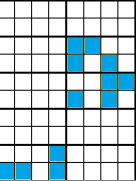Sampling > Multistage Sampling
What is Multistage Sampling?

Watch the video for an overview of multistage sampling, examples, plus advantages and disadvantages:
Let’s say you wanted to find out which subjects U.S. school children preferred. A population list—a list of all U.S. schoolchildren—would be near-impossible to come by, so you cannot take a sample of the population. Instead, you divide the population into states and take a simple random sample of states. For the next stage, you might take a simple random sample of schools from within those states. Finally you could perform simple random sampling on the students within the schools to get your sample.
In order to classify multistage sampling as probability sampling, each stage must involve a probability sampling method.
Advantages and Disadvantages
Multistage sampling is flexible, cost effective and easy to implement. You can use as many stages as you need to reduce the sample to a workable size, with no restrictions on how you divide the groups.
However, as the method has a subjective component, it has problems with external validity. It is also less accurate than simple random sampling.
Real Life Examples of Multistage Sampling
- The Census Bureau uses multistage sampling for the U.S. National Center for
Health Statistics’ National Health Interview Survey (NHIS). A multistage probability sample of 42,000 households in 376 probability sampling units (PSUs are usually counties or groups of counties), which are chosen in groups of around four adjacent households. - The Gallup poll uses multistage sampling. For example, they might randomly choose a certain number of area codes then randomly sample a number of phone numbers from within each area code.
- Johnston et. al’s survey on drug use in high schools used three stage sampling: geographic areas, followed by high schools within those areas, followed by senior students in those schools.
- The Australian Bureau of Statistics divides cities into “collection districts”, then blocks, then households. Each stage uses random sampling, creating a need to list specific households only after the final stage of sampling.
References
Levine, D. (2014). Even You Can Learn Statistics and Analytics: An Easy to Understand Guide to Statistics and Analytics 3rd Edition. Pearson FT Press
McBurney, D. & White, T. (2009). Research Methods. Cengage Learning.